The Best Diets for Heart Health

In addition to regular exercise and not smoking, diet is one of the best ways to protect your heart. Here are the best diets for heart health.
The formula for calculating the area and perimeter of a parallelogram is basic knowledge. Please refer to the formula that Quantrimang.com has compiled below.
Table of Contents
The area of a parallelogram is measured by the size of the surface area, which is the visible flat part of the parallelogram.
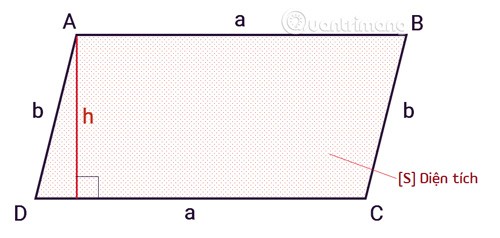
The area of a parallelogram is calculated by the formula equal to the product of the base times the height.
SABCD = axh
In there:
Sis the area of a parallelogram.ais the base of the parallelogram.his the height, from the top to the base, of a parallelogram.The perimeter of a parallelogram is calculated by adding the length of the lines surrounding the shape, which is also the line surrounding the entire area, equal to 2 times the sum of any pair of adjacent sides.
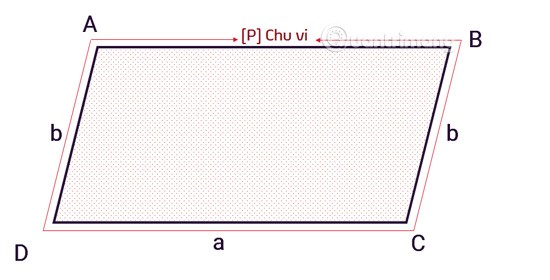
In other words, the perimeter of a parallelogram is the sum of the lengths of its four sides. The specific formula is as follows:
C = 2 x (a+b)
In there:
Cis the perimeter of a parallelogram.aand bare adjacent sides of a parallelogram.Define
A parallelogram is a quadrilateral with 2 pairs of parallel sides or 1 pair of parallel and equal sides. A parallelogram has 2 equal opposite angles and 2 diagonals that intersect at the midpoint of the shape.
Parallelogram can be considered a special case of trapezoid.
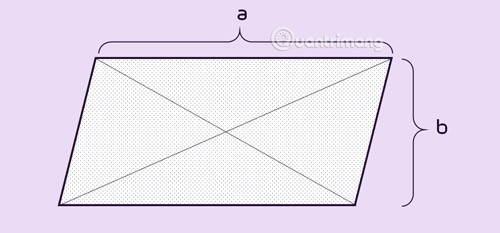
Properties of parallelogram
In parallelogram:
ABCD is a parallelogram, AC intersects BD at O. Then:
• AB = CD, AD = BC
•
• OA = OC, OB = OD
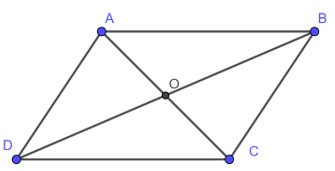
Signs of recognition
a) A quadrilateral with opposite sides parallel is a parallelogram.
b) A quadrilateral with opposite sides equal is a parallelogram.
c) A quadrilateral with two opposite sides parallel and equal is a parallelogram.
d) A quadrilateral with opposite angles equal to each other is a parallelogram.
e) A quadrilateral with two diagonals intersecting at the midpoint of each is a parallelogram.
Exercise 1 : Choose the wrong sentence.
A. A parallelogram has two diagonals intersecting at the midpoint of each diagonal.
B. Parallelogram has two equal opposite angles
C. A parallelogram has two diagonals perpendicular to each other.
D. Two parallelograms have two pairs of parallel opposite sides.
Solution
In parallelogram:
+ Parallelogram has opposite sides parallel
+ Opposite sides are equal
+ Two diagonals intersect at the midpoint of each line so C is incorrect.
The correct answer is: C
Exercise 2 : Given parallelogram ABCD with  = α > 900. Draw equilateral triangles ADE, ABF outside the parallelogram. What kind of triangle is triangle CEF? Choose the most correct answer.
A. Triangle
B. Isosceles triangle
C. Equilateral triangle
D. Obtuse triangle
Answer:
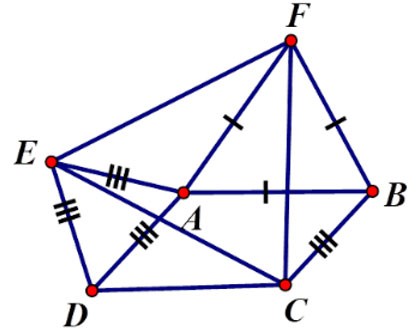
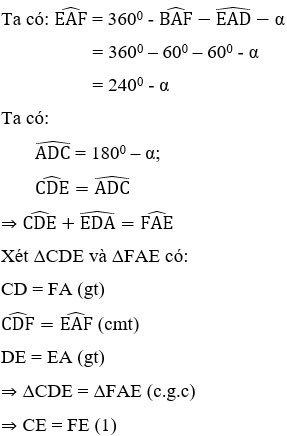
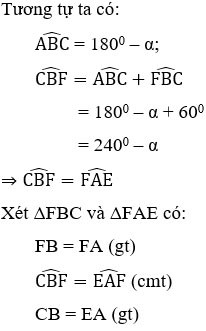
⇒ ΔFBC = ΔFAE (cgc) ⇒ CF = FE (2)
From (1) and (2) we can deduce that CF = FE = EC, so triangle CEF is equilateral.
Lesson 3 : Choose the wrong sentence. ABCD is a parallelogram. Then:
A. AB = CD
B. AD = BC
C. Parallelogram test with answers
D. AC = BD
Solution
In parallelogram:
+ Parallelogram has opposite sides parallel
+ Opposite sides are equal
+ Two diagonals intersect at the midpoint of each line so D is incorrect.
Lesson 4 : Fill in the blank with the appropriate phrase: “A quadrilateral with two diagonals… is a parallelogram.”
A. equal
B. intersect
C. intersect at the midpoint of each line
D. parallel
Solution
Signs:
A quadrilateral with two diagonals intersecting at the midpoint of each is a parallelogram.
Lesson 5 : Choose the wrong sentence:
A. A quadrilateral with two pairs of parallel opposite sides is a parallelogram.
B. A trapezoid with two equal angles adjacent to a base is a parallelogram.
C. A quadrilateral with two pairs of equal opposite sides is a parallelogram.
D. A quadrilateral with two pairs of equal opposite angles is a parallelogram.
Solution
Signs:
+ A quadrilateral with opposite parallel sides is a parallelogram so A is correct.
+ A quadrilateral with opposite sides equal is a parallelogram so D is correct.
+ A quadrilateral with opposite angles equal to each other is a parallelogram so D is correct.
Realizing that a trapezoid with two equal angles adjacent to a base is an isosceles trapezoid, so B is incorrect.
The correct answer is: B
Example 1 : Given a parallelogram with a base of 12cm, a side of 7cm, and a height of 5cm. Calculate the perimeter and area of that parallelogram?
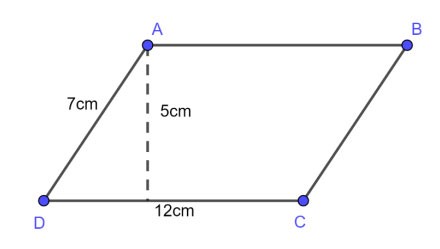
Prize:
The perimeter of the parallelogram is:
P = 2 x (12 + 7) = 38 (cm)
The area of a parallelogram is:
S = axh = 12 x 5 = 60 (cm2)
Example 2:
Given parallelogram ABCD with H, K being the feet of the altitudes drawn from vertices A, C to BD, respectively.
a) Prove that AHCK is a parallelogram.
b) Let O be the midpoint of HK. Prove that A, O, C are collinear.
Instruct:
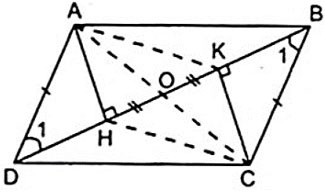
a) From the hypothesis we have:
 ⇒ AH//CK. ( 1 )
⇒ AH//CK. ( 1 )
Applying properties of sides of parallelograms and properties of alternate angles, we have:
 ⇒ Δ ADH = Δ CBK
⇒ Δ ADH = Δ CBK
(hypotenuse – acute angle case)
⇒ AH = CK (corresponding sides are equal) ( 2 )
From (1) and (2) we have quadrilateral AHCK with opposite sides parallel and equal is a parallelogram.
b) Apply the properties of diagonals of parallelogram AHCK
Parallelogram AHCK has two diagonals AC and HK intersecting at the midpoint of each. Since O is the midpoint of HK, O is also the midpoint of AC.
⇒ A, O, C are on a straight line.
In addition to parallelograms, the formulas for calculating the area and perimeter of other common geometric shapes such as rhombuses , squares , trapezoids , rectangles ... are also very important and widely applied in study and life.
Hopefully through the above article, you have a better understanding and grasp of the basic knowledge about parallelograms. Please leave a comment below if you have any questions or comments to discuss with Quantrimang.com.
In addition to regular exercise and not smoking, diet is one of the best ways to protect your heart. Here are the best diets for heart health.
Diet is important to our health. Yet most of our meals are lacking in these six important nutrients.
At first glance, AirPods look just like any other true wireless earbuds. But that all changed when a few little-known features were discovered.
In this article, we will guide you how to regain access to your hard drive when it fails. Let's follow along!
Dental floss is a common tool for cleaning teeth, however, not everyone knows how to use it properly. Below are instructions on how to use dental floss to clean teeth effectively.
Building muscle takes time and the right training, but its something anyone can do. Heres how to build muscle, according to experts.
The third trimester is often the most difficult time to sleep during pregnancy. Here are some ways to treat insomnia in the third trimester.
There are many ways to lose weight without changing anything in your diet. Here are some scientifically proven automatic weight loss or calorie-burning methods that anyone can use.
Apple has introduced iOS 26 – a major update with a brand new frosted glass design, smarter experiences, and improvements to familiar apps.
Yoga can provide many health benefits, including better sleep. Because yoga can be relaxing and restorative, its a great way to beat insomnia after a busy day.
The flower of the other shore is a unique flower, carrying many unique meanings. So what is the flower of the other shore, is the flower of the other shore real, what is the meaning and legend of the flower of the other shore?
Craving for snacks but afraid of gaining weight? Dont worry, lets explore together many types of weight loss snacks that are high in fiber, low in calories without making you try to starve yourself.
Prioritizing a consistent sleep schedule and evening routine can help improve the quality of your sleep. Heres what you need to know to stop tossing and turning at night.
Adding a printer to Windows 10 is simple, although the process for wired devices will be different than for wireless devices.
You want to have a beautiful, shiny, healthy nail quickly. The simple tips for beautiful nails below will be useful for you.













